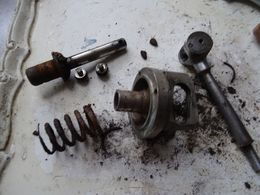

Origin of the machine: Italy
Country of purchase: Italy
Type: Spring lever
Serial No: 5216
Power: 750w + 250w
Closed boiler
Tamper diameter: 51 mm
One double filter basket

Translated by Gary Seeman
I knew from having found it on the net that I am one of a lucky few. There are no more than four or five. This Duchessa brand, which will eventually take the name La Ducale, has been the subject of much envy. Is it the rarity, quality workmanship, aesthetics, choice of name that makes it so coveted? Duchessa or Ducale are names that appear like stars in the eyes of many people,
including me.
A big thank you to my friend, Lucio del Piccolo, without whom this machine would not be mine today!









I am too preoccupied with the joy of discovery, even if I see things that should make me concerned, like electrical components that are more than old.
This is when I hope that the heating elements are not damaged. Because finding that these days ....
I see that the Plexiglas top is missing, the drip grate, and also the top cowling of the group.
The steam wand and hot water tap are also missing.
Well, it does not diminish my enthusiasm not too much in the end.

Having had some problems with my manometers recently, I hope it will be operational.
I would be sad to change it, like losing the hood ornament on a Rolls.
After several days of anguish, the carton finally arrives.
This machine is very heavy, and it just traveled nearly 2000 km.
And the heating elements rare at the bottom of the boiler, one over the other.
The boiler at first glance seems to have lots of limescale.
It will be a great alternative to the Zenith with which I can ensure daily heating of 6 liters and with the La Pavoni, which,
even if it is the "Professional” model is problematic when there are several coffee lovers at home.
It is a pity that this format has not been exploited more as is done with the Sama Club, for example.
It really is the perfect link between the small home lever machine and the massive machine for coffee bars.
to realize it is not too bad, so dismantling proceeds.
With the rear panel removed I can now explore the innards of the machine, which reveals a true surprise.
Indeed I have seen a few pictures of the inside of a Duchessina and the pressure switch that controlled its unique heating configuration.
But here I find something puzzling. It is equipped with two heating elements for minimum and maximum like the early La Pavonis.
But why does it have this switch and two heating coils?
There limestone everywhere.
frosted dessert.
I continue with the group, which seems not in better shape.
The spring is mostly rusted away …

To be continued ...



